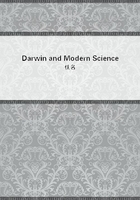
第104章
I. ANIMALS.
By W.B. SCOTT.
Professor of Geology in the University of Princeton, U.S.A.
To no branch of science did the publication of "The Origin of Species"prove to be a more vivifying and transforming influence than to Palaeontology. This science had suffered, and to some extent, still suffers from its rather anomalous position between geology and biology, each of which makes claim to its territory, and it was held in strict bondage to the Linnean and Cuvierian dogma that species were immutable entities. There is, however, reason to maintain that this strict bondage to a dogma now abandoned, was not without its good side, and served the purpose of keeping the infant science in leading-strings until it was able to walk alone, and preventing a flood of premature generalisations and speculations.
As Zittel has said: "Two directions were from the first apparent in palaeontological research--a stratigraphical and a biological.
Stratigraphers wished from palaeontology mainly confirmation regarding the true order or relative age of zones of rock-deposits in the field.
Biologists had, theoretically at least, the more genuine interest in fossil organisms as individual forms of life." (Zittel, "History of Geology and Palaeontology", page 363, London, 1901.) The geological or stratigraphical direction of the science was given by the work of William Smith, "the father of historical geology," in the closing decade of the eighteenth century. Smith was the first to make a systematic use of fossils in determining the order of succession of the rocks which make up the accessible crust of the earth, and this use has continued, without essential change, to the present day. It is true that the theory of evolution has greatly modified our conceptions concerning the introduction of new species and the manner in which palaeontological data are to be interpreted in terms of stratigraphy, but, broadly speaking, the method remains fundamentally the same as that introduced by Smith.
The biological direction of palaeontology was due to Cuvier and his associates, who first showed that fossils were not merely varieties of existing organisms, but belonged to extinct species and genera, an altogether revolutionary conception, which startled the scientific world.
Cuvier made careful studies, especially of fossil vertebrates, from the standpoint of zoology and was thus the founder of palaeontology as a biological science. His great work on "Ossements Fossiles" (Paris, 1821)has never been surpassed as a masterpiece of the comparative method of anatomical investigation, and has furnished to the palaeontologist the indispensable implements of research.
On the other hand, Cuvier's theoretical views regarding the history of the earth and its successive faunas and floras are such as no one believes to-day. He held that the earth had been repeatedly devastated by great cataclysms, which destroyed every living thing, necessitating an entirely new creation, thus regarding the geological periods as sharply demarcated and strictly contemporaneous for the whole earth, and each species of animal and plant as confined to a single period. Cuvier's immense authority and his commanding personality dominated scientific thought for more than a generation and marked out the line which the development of palaeontology was to follow. The work was enthusiastically taken up by many very able men in the various European countries and in the United States, but, controlled as it was by the belief in the fixity of species, it remained almost entirely descriptive and consisted in the description and classification of the different groups of fossil organisms. As already intimated, this narrowness of view had its compensations, for it deferred generalisations until some adequate foundations for these had been laid.